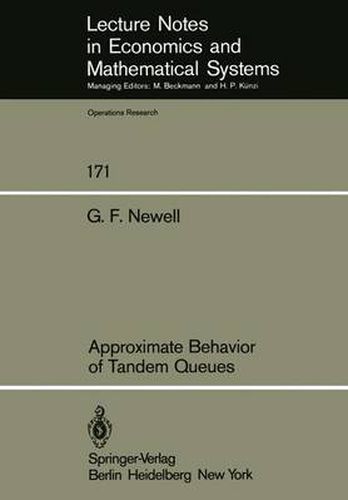Readings Newsletter
Become a Readings Member to make your shopping experience even easier.
Sign in or sign up for free!
You’re not far away from qualifying for FREE standard shipping within Australia
You’ve qualified for FREE standard shipping within Australia
The cart is loading…






This title is printed to order. This book may have been self-published. If so, we cannot guarantee the quality of the content. In the main most books will have gone through the editing process however some may not. We therefore suggest that you be aware of this before ordering this book. If in doubt check either the author or publisher’s details as we are unable to accept any returns unless they are faulty. Please contact us if you have any questions.
The following monograph deals with the approximate stochastic behavior of a system consisting of a sequence of servers in series with finite storage between consecutive servers. The methods employ deterministic queueing and diffusion approximations which are valid under conditions in which the storages and the queue lengths are typically large compared with 1. One can disregard the fact that the customer counts must be integer valued and treat the queue as if it were a (stochastic) continuous fluid. In these approximations, it is not necessary to describe the detailed probability distribution of service times; it suffices simply to specify the rate of service and the variance rate (the variance of the number served per unit time). Specifically, customers are considered to originate from an infinite reservoir. They first pass through a server with service rate ~O’ vari ance rate ~O’ into a storage of finite capacity c . They then pass l through a server with service rate ~l’ variance rate ~l’ into a storage of capacity c ‘ etc., until finally, after passing through an nth server, 2 they go into an infinite reservoir (disappear). If any jth storage become , n , the service at the j-lth server is interrupted full j = 1, 2, and, of course, if a jth storage becomes empty the jth server is inter rupted; otherwise, services work at their maximum rate.
$9.00 standard shipping within Australia
FREE standard shipping within Australia for orders over $100.00
Express & International shipping calculated at checkout
This title is printed to order. This book may have been self-published. If so, we cannot guarantee the quality of the content. In the main most books will have gone through the editing process however some may not. We therefore suggest that you be aware of this before ordering this book. If in doubt check either the author or publisher’s details as we are unable to accept any returns unless they are faulty. Please contact us if you have any questions.
The following monograph deals with the approximate stochastic behavior of a system consisting of a sequence of servers in series with finite storage between consecutive servers. The methods employ deterministic queueing and diffusion approximations which are valid under conditions in which the storages and the queue lengths are typically large compared with 1. One can disregard the fact that the customer counts must be integer valued and treat the queue as if it were a (stochastic) continuous fluid. In these approximations, it is not necessary to describe the detailed probability distribution of service times; it suffices simply to specify the rate of service and the variance rate (the variance of the number served per unit time). Specifically, customers are considered to originate from an infinite reservoir. They first pass through a server with service rate ~O’ vari ance rate ~O’ into a storage of finite capacity c . They then pass l through a server with service rate ~l’ variance rate ~l’ into a storage of capacity c ‘ etc., until finally, after passing through an nth server, 2 they go into an infinite reservoir (disappear). If any jth storage become , n , the service at the j-lth server is interrupted full j = 1, 2, and, of course, if a jth storage becomes empty the jth server is inter rupted; otherwise, services work at their maximum rate.